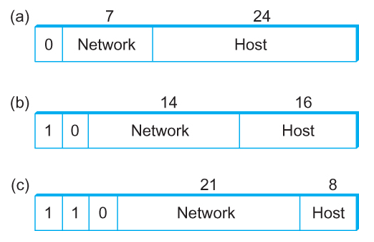Global addresses:
- Properties:
- Globally unique
- Hierarchical: network + host
- 4 billion IP Addresses, half are A type, 1/4 are B type, 1/8 are C type

In the olden days, only fixed allocation sizes:
| Class | Most significant bits | CIDR | Address range | Notes |
|---|---|---|---|---|
| A | 0 | /8 | 0.0.0.0–127.255.255.255 | 126 different networks possible (0 and 127 reserved) |
| B | 10 | /16 | 128.0.0.0–191.255.255.255 | networks possible |
| C | 110 | /24 | 192.0.0.0–223.255.255.255 | networks possible, 254 hosts per network |
| D | 1110 | - | - | For multicast groups |
| E | 11110 | - | - | Reserved for future use |
This is why people use dotted-quad notation
Problems with Classful Addressing
- Wastage of addresses
- Bigger tables to look up at routers
- Because there’s a limited number of class A and class B networks, most people will have to use class C networks
- But class C networks are not big enough for their purposes
- So they’ll have to get themselves multiple class C networks instead of just one network of the right size
- Hence, more entries in routing tables